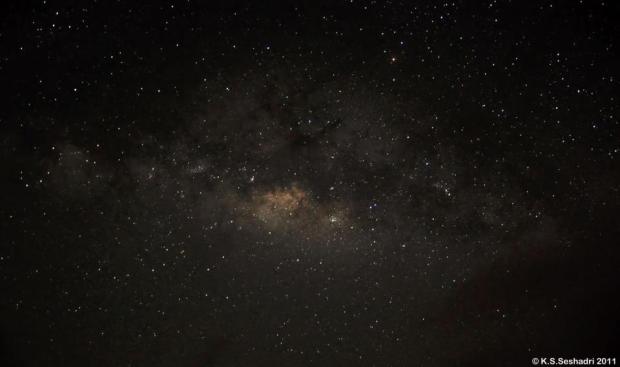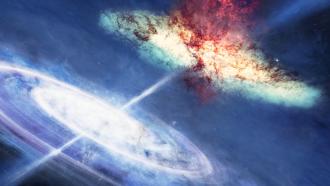
PC: Seshadri K S/ Research Matters
When the European Space Agency (ESA) released a catalogue containing precise positions and brightnesses of 1142 million stars of the Milky Way on September 14, 2016, it was a treasure trove of information for astronomers. Gaia, a space-based telescope launched on December 19, 2013 by the ESA, is on its mission to study the evolution of our galaxy. As of today, it is observing approximately one billion celestial bodies including stars, planets, comets, asteroids and quasars in the Milky Way, building the most accurate three-dimensional map of our galaxy we have till now. A billion celestial bodies make just one percent of our galaxy’s population – a scale unimaginable by most of us. Nevertheless, the tremendous data generated by Gaia will be used for determining the positions and motions of stars (astrometry), measuring the colours of the stars (photometry) and measuring the radial velocity (spectroscopy) and studying the constituents of stars.
The name Gaia is derived from “Global Astrometric Interferometer for Astrophysics” (GAIA), an electromagnetic waves based measurement technique, used in the telescope. However, the acronym GAIA has been dropped and now the name Gaia remains. The project was proposed by Prof. Lennart Lindegren of the Lund University, Sweden and Dr. Michael Perryman of the ESA in October 1993, and was authorised by ESA in 2006.
But why do we need to study stars? The history of attempting to map the night sky is as old as time. The ancient Greeks, Babylonians, Mesopotamians and Indians were very sophisticated astronomers and used elaborate clay tablets, detailed star charts and star maps for mapping the positions of stars and planets. These stellar positions were used to calculate direction, time and seasons. Numerous primitive observatories around the world were built to monitor and study the stellar positions. Jantar Mantar, located in New Delhi and built by Maharaja Jai Singh II of Jaipur, is one of those.
Though the curiosity to study the night sky has remained, the process is now aided with sophisticated telescopes and space probes which give accurate and up-to-date information on celestial objects to improve our understanding of the Universe. However, the night sky is not as calm and tranquil as it looks – it is peppered with countless stars bursting into life and imploding to their death, all invisible to our eyes. With technological advancements and space probes like Gaia, the origin, structure and evolution of these stars and galaxies can be uncovered.
The ESA’s first space mission dedicated to mapping the sky was called Hipparcos and was launched in the year 1989. "Hipparcos" was an acronym for High Precision Parallax Collecting Satellite, and it also reflected the name of the ancient Greek astronomer Hipparchus, who is considered the founder of trigonometry and the discoverer of the precession of the equinoxes (due to the Earth wobbling on its axis). It catalogued nearly 120,000 stars in its lifetime. Gaia is the successor of Hipparcos and is extending this effort by measuring ten thousand times more stars and other celestial objects and their motions.
With a mission lifetime of five years, Gaia would have observed each star in the galaxy over 70 times. “Besides directly mapping the night sky, Gaia will measure distances to one billion stars in the Milky Way. To work out distances of objects outside our galaxy, astronomers rely on what is known as the “distance ladder”. Measurements of distances to far off quasars or galaxies depend on knowing distances to nearby objects within our galaxy accurately. Gaia will measure distances to one billion stars in the Milky Way to unprecedented precision”, comments Dr. Vimal Simha, a postdoctoral researcher at the Centre for Extragalactic Theory, Cape Town.
So where in the sky is Gaia placed? In order to measure the position of stars with high precision, Gaia has to be positioned in a gravitationally stable orbit. There are five such naturally occurring points where the net gravitational force of the Sun and the Earth cancel each other. They are called Lagrangian points, named after Italian astronomer, Joseph Louis Lagrange (1736-1813). Gaia is positioned at Lagrange-2 (L2) point which lies 1.5 million kilometres from the Earth in the opposite direction to the Sun and co-rotates with the Earth around the Sun. Other advantages of the L2 orbit is that it offers uninterrupted, eclipse-free, observations with the ability to observe the entire celestial sphere during the course of one year.
Gaia contains two telescopes pointing towards two different patches of the sky, 106.5 degrees apart. At the heart of the telescopes are Charge Coupled Device (CCD) detectors which are sensitive to a single photon of light. This high sensitivity records stars which are 400 thousand times fainter than the stars visible to naked eye. To measure the distance of stars relative to each other, Gaia measures the parallax angle of the stars. Parallax is the effect whereby the position or direction of an object appears to differ when viewed from different positions. Stars with high parallax angle are nearer and those with low parallax angle are far. Gaia aims to map every object in sky with a resolution of 20 micro arcseconds, enough to see a waving hand on the moon from the Earth. Although Gaia’s mirrors are not large enough, they are polished to up to 10 nanometers of accuracy. Since there is no atmosphere in space to blur the image, Gaia captures clear images with high resolution.
Stellar catalogues are to astronomers, what a map is to sailors. “A stellar catalogue, as the name suggests, is a systematic list of physical parameters of stars. Gaia will produce a catalogue containing positions, brightnesses and colours for a billion stars in the Milky Way. Moreover, because the positions of stars will be measured many times, astronomers will be able to work out the speed and direction of motion of stars”, explains Dr. Simha. To carry out this complicated endeavour, ESA has constituted the Data Processing and Analysis Consortium (DPAC), a team of 450 scientists and software experts who will analyse the data generated by Gaia.
Most of the stars are so far away from Earth that it is impossible for us to send spacecraft and study them in our lifetime. Hence, astronomers rely on clues like radiations emitted by stars, their colour, etc. to study their mass, temperature, age, composition and other properties. “Gaia's principal objective is to make the most detailed map ever of our galaxy. This will help us understand the origin and evolution of the Milky Way galaxy. For example, it will help us understand some phases of evolution of stars that are, at present, not so well understood because of the paucity of data. Because it's a large map of the sky, astronomers can also use it for other things - to look for extrasolar planets, brown dwarfs and massive explosions known as supernovae in other galaxies”, adds Dr. Simha, reiterating the benefits of such missions.
Researchers across the world are already taking advantage of the data that is released and are working on project proposals that can harness this information. “The first release of Gaia data available on the Gaia archive is already being used for projects along the lines of understanding our galaxy’s evolution and its constituents”, says Dr. Simha. This endeavour will surely open new avenues in the field of astronomy, and shed some light on some of the fundamental questions about the existence of Milky Way.






